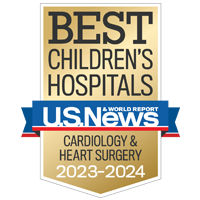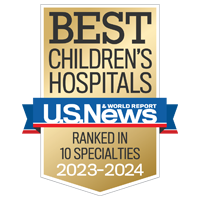Learning never stops
Our classroom and bedside classes help kids get credit and keep learning during treatment.
See our school program

Ventricular tachycardia (VT) is a type of arrhythmia, in which the heart beats at an abnormally fast rate. This may cause the heart to pump less effectively, causing a decrease in blood pressure, which may lead to fainting.
The "normal" number of heartbeats per minute, called pulse rate, varies with age. The heart beats about 140 times a minute in a newborn, compared to 70 times a minute in an older child at rest. Heart rate is not constant, changing in response to many factors, such as activity, fever or fear. In VT, the heart beats too quickly, as fast as 200 to 300 beats per minute, which prevents the heart from filling completely with blood and the body from receiving the blood volume it needs to function properly.
VT can result from scarring in the heart due to a previous surgery or diseased heart muscle or cells. Diseased heart muscle or cells may be found in children with inherited heart defects, such as cardiomyopathy or right ventricular dysplasia.
Ventricular tachycardia (VT) may cause the following symptoms:
It is important to note that children may not know how to describe what they are feeling during a period of VT. They may have trouble keeping up with other children or realize they are having "spells" and want to sit down and rest. On occasion, a child may not experience any symptoms at all.
Ventricular tachycardia often occurs spontaneously with unpredictable timing, and specialized tests are needed to make an accurate diagnosis. If your doctor suspects that your child has an arrhythmia such as ventricular tachycardia, he or she will order one or more of the following diagnostic tests to determine the source of your child's symptoms:
Treatment for your child's ventricular tachycardia (VT) will depend on the type and severity of your child's condition and the results of their diagnostic tests, such as the electrophysiology (EP) study. You and your doctor will decide which treatment is right for your child.
The following treatments may be considered:
Certain anti-arrhythmic drugs change the electrical signals in the heart and help prevent irregular or rapid heart rhythms. Medication may be used to convert ventricular tachycardia to a normal rhythm, slow down the heart rate or prevent recurrences.
On occasion, we admit children to the hospital and monitor their heart rhythm while we start the medication. To make sure that your child's medication is working properly, your child may be brought to the Electrophysiology Laboratory for an electrophysiology (EP) study. Our goal is to find the medication that works best for your child.
Radiofrequency catheter ablation (RFA) is a technique to treat arrhythmia that was pioneered at UCSF Medical Center. It disrupts part of the electrical pathway causing irregular heart rhythms, providing relief for patients who may not respond well to medications, who prefer not to take medications or who can't take medications.
The procedure involves threading a tiny, metal-tipped catheter through a vein or artery in the leg and into the heart. Using fluoroscopy or X-ray, doctors guide the catheter through a blood vessel to the heart. Additional catheters, inserted through the vein in the leg and the neck, contain electrical sensors to find the area causing the arrhythmia. This is called mapping.
The metal-tipped catheter is maneuvered to each site in the heart that causes the irregular heartbeat. Radiofrequency waves or current is sent through the tip of the catheter, cauterizing or burning cells to destroy the extra electrical pathways that cause abnormal heart rhythms. In most cases, patients leave the hospital within 24 hours or the same day.
RFA has been proven very effective in treating children with arrhythmias. Your doctor will discuss this treatment and others with you to decide the best option for you or your child.
Cryoablation, sometimes referred to as cryo, is similar to radiofrequency catheter ablation in that it is a procedure that disrupts the abnormal electrical pathway in the heart. Instead of burning cells, however, cryoablation destroys cells by freezing them. This newer technology has been used in the Electrophysiology Laboratory at UCSF Benioff Children's Hospital since March 2004.
Cryoablation has been very effective in treating children with arrhythmias. Your doctor will discuss this treatment and others with you to decide which method is the best option.
Like radiofrequency catheter ablation, cryoablation involves threading a tiny, metal-tipped catheter through a vein or artery in the leg and into the heart. Doctors guide the catheter through the blood vessel to the heart by using fluoroscopy or X-ray. Additional catheters, inserted through the vein in the leg and the neck, contain electrical sensors to help "map" or find the area causing the arrhythmia.
The metal-tipped catheter is maneuvered to areas in the heart that cause the irregular heart rhythm. Then, cryoablation freezes the cells or extra electrical pathways that cause abnormal heart rhythms. In most cases, patients leave the hospital within 24 hours or the same day.
An implantable cardioverter defibrillator (ICD) may be the best form of therapy for VT in some cases, such as when the VT is causing a very fast heart rhythm that could lead to cardiac arrest. An ICD is not a cure for rhythm problems, but it may stop a very fast heart rhythm and bring the heartbeat back to normal.
UCSF Benioff Children's Hospitals medical specialists have reviewed this information. It is for educational purposes only and is not intended to replace the advice of your child's doctor or other health care provider. We encourage you to discuss any questions or concerns you may have with your child's provider.

Best in Northern California for cardiology & heart surgery

Ranked among the nation's best in 10 specialties
Learning never stops
